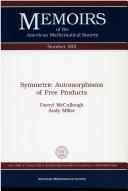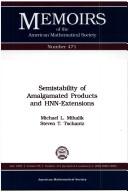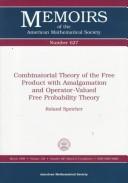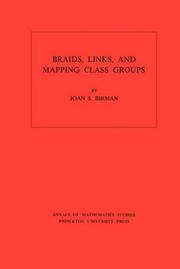| Listing 1 - 10 of 14 | << page >> |
Sort by
|

ISSN: 00659266 ISBN: 0821804596 Year: 1996 Publisher: Providence (R.I.): American Mathematical Society
Abstract | Keywords | Export | Availability | Bookmark
 Loading...
Loading...Choose an application
- Reference Manager
- EndNote
- RefWorks (Direct export to RefWorks)
Group theory --- Free products (Group theory) --- Automorphisms. --- Automorphismes. --- Automorphisms --- Products, Free (Group theory) --- Symmetry (Mathematics)
Dissertation
Year: 2020 Publisher: Liège Université de Liège (ULiège)
Abstract | Keywords | Export | Availability | Bookmark
 Loading...
Loading...Choose an application
- Reference Manager
- EndNote
- RefWorks (Direct export to RefWorks)
The goal of this Master thesis is to study several properties of dendric sets or words, which generalise Arnoux-Rauzy words and codings of regular interval exchanges. These properties mainly focus on prefix, suffix and bifix codes included in such a set and on the free group. One of the main results states that, in a recurrent dendric set, the set of (first) return words of any word is a basis of the free group. Using this result and various graphs and automata, I study several properties which then give me, among other results, the stability of the family of recurrent dendric sets under bifix decoding. Finally, I briefly introduce S-adic representations and give a particular representation for recurrent dendric words. Ce mémoire a pour but d'étudier différentes propriétés des ensembles ou mots dendriques qui sont une généralisation des mots d'Arnoux-Rauzy et des codages d'intervalles réguliers. Ces propriétés sont essentiellement centrées autour des codes préfixes, suffixes et bifixes inclus dans un tel ensemble et autour de la notion de groupe libre. Un des résultats majeurs affirme que dans un ensemble dendrique récurrent, les mots de (premier) retour pour n'importe quel mot forment une base du groupe libre. En utilisant des graphes et des automates particuliers, nous étudions ensuite diverses propriétés qui nous permettent entre autres d'obtenir la stabilité de la famille des ensembles dendriques récurrents pour l'opération de décodage bifixe. Enfin, nous introduisons brièvement la notion de représentation S-adique et donnons une représentation particulière pour les mots dendriques récurrents.
discrete mathematics --- words --- dendric --- bifix code --- free group --- mathématiques discrètes --- mots --- dendrique --- code bifixe --- groupe libre --- Physique, chimie, mathématiques & sciences de la terre > Mathématiques

ISBN: 9780821839454 0821839454 Year: 2007 Publisher: Providence American Mathematical Society
Abstract | Keywords | Export | Availability | Bookmark
 Loading...
Loading...Choose an application
- Reference Manager
- EndNote
- RefWorks (Direct export to RefWorks)
Group theory --- 51 <082.1> --- Mathematics--Series --- Geometric group theory --- Statistical decision --- Free products (Group theory) --- Equations, Quadratic --- Groupes, Théorie géométrique des --- Prise de décision (statistique) --- Équations du second degré --- Decision problems --- Game theory --- Operations research --- Statistics --- Management science --- Products, Free (Group theory) --- Quadratic equations --- Groupes, Théorie géométrique des. --- Équations du second degré.

ISBN: 0821825313 Year: 1992 Publisher: Providence (R.I.): American Mathematical Society
Abstract | Keywords | Export | Availability | Bookmark
 Loading...
Loading...Choose an application
- Reference Manager
- EndNote
- RefWorks (Direct export to RefWorks)
Mathematical analysis --- Free products (Group theory) --- Geometric group theory --- HNN-extensions --- Extensions, Higman-Neumann-Neumann --- Extensions, HNN --- -Higman-Neumann-Neumann extensions --- Group extensions (Mathematics) --- Group theory --- Products, Free (Group theory) --- Extensions HNN --- Groupes, Théorie géométrique des --- Groupes, Théorie des --- Extensions HNN. --- Groupes, Théorie géométrique des. --- Groupes, Théorie des.

ISSN: 00659266 ISBN: 0821806939 Year: 1998 Publisher: Providence (R.I.): American Mathematical Society
Abstract | Keywords | Export | Availability | Bookmark
 Loading...
Loading...Choose an application
- Reference Manager
- EndNote
- RefWorks (Direct export to RefWorks)
Probability theory --- Operator-valued functions. --- Selfadjoint operators. --- Free products (Group theory) --- Combinatorial analysis. --- Free probability theory. --- Fonctions à valeurs opératorielles. --- Opérateurs auto-adjoints. --- Produits libres (théorie des groupes) --- Analyse combinatoire. --- Combinatorial analysis --- Free probability theory --- Operator-valued functions --- Selfadjoint operators --- Operators, Selfadjoint --- Self-adjoint operators --- Linear operators --- Operator functions --- Functional analysis --- Products, Free (Group theory) --- Group theory --- Probability theory, Free --- Operator algebras --- Combinatorics --- Algebra --- Mathematical analysis
Book
Year: 2017 Publisher: Princeton, NJ : Princeton University Press,
Abstract | Keywords | Export | Availability | Bookmark
 Loading...
Loading...Choose an application
- Reference Manager
- EndNote
- RefWorks (Direct export to RefWorks)
Geometric group theory is the study of the interplay between groups and the spaces they act on, and has its roots in the works of Henri Poincaré, Felix Klein, J.H.C. Whitehead, and Max Dehn. Office Hours with a Geometric Group Theorist brings together leading experts who provide one-on-one instruction on key topics in this exciting and relatively new field of mathematics. It's like having office hours with your most trusted math professors.An essential primer for undergraduates making the leap to graduate work, the book begins with free groups-actions of free groups on trees, algorithmic questions about free groups, the ping-pong lemma, and automorphisms of free groups. It goes on to cover several large-scale geometric invariants of groups, including quasi-isometry groups, Dehn functions, Gromov hyperbolicity, and asymptotic dimension. It also delves into important examples of groups, such as Coxeter groups, Thompson's groups, right-angled Artin groups, lamplighter groups, mapping class groups, and braid groups. The tone is conversational throughout, and the instruction is driven by examples.Accessible to students who have taken a first course in abstract algebra, Office Hours with a Geometric Group Theorist also features numerous exercises and in-depth projects designed to engage readers and provide jumping-off points for research projects.
Geometric group theory. --- "ient. --- 4-valent tree. --- Cantor set. --- Cayley 2-complex. --- Cayley graph. --- Coxeter group. --- DSV method. --- Dehn function. --- Dehn twist. --- Euclidean space. --- Farey complex. --- Farey graph. --- Farey tree. --- Gromov hyperbolicity. --- Klein's criterion. --- Milnor-Schwarz lemma. --- Möbius transformation. --- Nielsen-Schreier Subgroup theorem. --- Perron-Frobenius theorem. --- Riemannian manifold. --- Schottky lemma. --- Thompson's group. --- asymptotic dimension. --- automorphism group. --- automorphism. --- bi-Lipschitz equivalence. --- braid group. --- braids. --- coarse isometry. --- combinatorics. --- compact orientable surface. --- cone type. --- configuration space. --- context-free grammar. --- curvature. --- dead end. --- distortion. --- endomorphism. --- finite group. --- folding. --- formal language. --- free abelian group. --- free action. --- free expansion. --- free group. --- free nonabelian group. --- free reduction. --- generators. --- geometric group theory. --- geometric object. --- geometric space. --- graph. --- group action. --- group element. --- group ends. --- group growth. --- group presentation. --- group theory. --- group. --- homeomorphism. --- homomorphism. --- hyperbolic geometry. --- hyperbolic group. --- hyperbolic space. --- hyperbolicity. --- hyperplane arrangements. --- index. --- infinite graph. --- infinite group. --- integers. --- isoperimetric problem. --- isoperimetry. --- jigsaw puzzle. --- knot theory. --- lamplighter group. --- manifold. --- mapping class group. --- mathematics. --- membership problem. --- metric space. --- non-free action. --- normal subgroup. --- path metric. --- ping-pong lemma. --- ping-pong. --- polynomial growth theorem. --- product. --- punctured disks. --- quasi-isometric equivalence. --- quasi-isometric rigidity. --- quasi-isometry group. --- quasi-isometry invariant. --- quasi-isometry. --- reflection group. --- reflection. --- relators. --- residual finiteness. --- right-angled Artin group. --- robotics. --- semidirect product. --- space. --- surface group. --- surface. --- symmetric group. --- symmetry. --- topological model. --- topology. --- train track. --- tree. --- word length. --- word metric. --- word problem. --- "ient. --- 4-valent tree. --- Cantor set. --- Cayley 2-complex. --- Cayley graph. --- Coxeter group. --- DSV method. --- Dehn function. --- Dehn twist. --- Euclidean space. --- Farey complex. --- Farey graph. --- Farey tree. --- Gromov hyperbolicity. --- Klein's criterion. --- Milnor-Schwarz lemma. --- Möbius transformation. --- Nielsen-Schreier Subgroup theorem. --- Perron-Frobenius theorem. --- Riemannian manifold. --- Schottky lemma. --- Thompson's group. --- asymptotic dimension. --- automorphism group. --- automorphism. --- bi-Lipschitz equivalence. --- braid group. --- braids. --- coarse isometry. --- combinatorics. --- compact orientable surface. --- cone type. --- configuration space. --- context-free grammar. --- curvature. --- dead end. --- distortion. --- endomorphism. --- finite group. --- folding. --- formal language. --- free abelian group. --- free action. --- free expansion. --- free group. --- free nonabelian group. --- free reduction. --- generators. --- geometric group theory. --- geometric object. --- geometric space. --- graph. --- group action. --- group element. --- group ends. --- group growth. --- group presentation. --- group theory. --- group. --- homeomorphism. --- homomorphism. --- hyperbolic geometry. --- hyperbolic group. --- hyperbolic space. --- hyperbolicity. --- hyperplane arrangements. --- index. --- infinite graph. --- infinite group. --- integers. --- isoperimetric problem. --- isoperimetry. --- jigsaw puzzle. --- knot theory. --- lamplighter group. --- manifold. --- mapping class group. --- mathematics. --- membership problem. --- metric space. --- non-free action. --- normal subgroup. --- path metric. --- ping-pong lemma. --- ping-pong. --- polynomial growth theorem. --- product. --- punctured disks. --- quasi-isometric equivalence. --- quasi-isometric rigidity. --- quasi-isometry group. --- quasi-isometry invariant. --- quasi-isometry. --- reflection group. --- reflection. --- relators. --- residual finiteness. --- right-angled Artin group. --- robotics. --- semidirect product. --- space. --- surface group. --- surface. --- symmetric group. --- symmetry. --- topological model. --- topology. --- train track. --- tree. --- word length. --- word metric. --- word problem.
Book
ISBN: 0691080917 1400881781 9780691080918 Year: 1971 Volume: 68 Publisher: Princeton, N.J.
Abstract | Keywords | Export | Availability | Bookmark
 Loading...
Loading...Choose an application
- Reference Manager
- EndNote
- RefWorks (Direct export to RefWorks)
Part exposition and part presentation of new results, this monograph deals with that area of mathematics which has both combinatorial group theory and mathematical logic in common. Its main topics are the word problem for groups, the conjugacy problem for groups, and the isomorphism problem for groups. The presentation depends on previous results of J. L. Britton, which, with other factual background, are treated in detail.
Group theory --- 510.6 --- Mathematical logic --- 510.6 Mathematical logic --- Group theory. --- Logic, Symbolic and mathematical. --- Groupes, Théorie des --- Groups, Theory of --- Substitutions (Mathematics) --- Algebra --- Algebra of logic --- Logic, Universal --- Symbolic and mathematical logic --- Symbolic logic --- Mathematics --- Algebra, Abstract --- Metamathematics --- Set theory --- Syllogism --- Abelian group. --- Betti number. --- Characteristic function (probability theory). --- Characterization (mathematics). --- Combinatorial group theory. --- Conjecture. --- Conjugacy class. --- Conjugacy problem. --- Contradiction. --- Corollary. --- Cyclic permutation. --- Decision problem. --- Diffeomorphism. --- Direct product. --- Direct proof. --- Effective method. --- Elementary class. --- Embedding. --- Enumeration. --- Epimorphism. --- Equation. --- Equivalence relation. --- Exact sequence. --- Existential quantification. --- Finite group. --- Finite set. --- Finitely generated group. --- Finitely presented. --- Free group. --- Free product. --- Fundamental group. --- Fundamental theorem. --- Group (mathematics). --- Gödel numbering. --- Homomorphism. --- Homotopy. --- Inner automorphism. --- Markov property. --- Mathematical logic. --- Mathematical proof. --- Mathematics. --- Monograph. --- Natural number. --- Nilpotent group. --- Normal subgroup. --- Notation. --- Permutation. --- Polycyclic group. --- Presentation of a group. --- Quotient group. --- Recursive set. --- Requirement. --- Residually finite group. --- Semigroup. --- Simple set. --- Simplicial complex. --- Solvable group. --- Statistical hypothesis testing. --- Subgroup. --- Theorem. --- Theory. --- Topology. --- Transitive relation. --- Triviality (mathematics). --- Truth table. --- Turing degree. --- Turing machine. --- Without loss of generality. --- Word problem (mathematics). --- Groupes, Théorie des --- Décidabilité (logique mathématique)

ISBN: 0691120439 0691120447 1299133258 1400837170 9780691120430 9781400837175 9780691120447 Year: 2005 Volume: no. 157 Publisher: Princeton Princeton University Press
Abstract | Keywords | Export | Availability | Bookmark
 Loading...
Loading...Choose an application
- Reference Manager
- EndNote
- RefWorks (Direct export to RefWorks)
In recent years, considerable progress has been made in studying algebraic cycles using infinitesimal methods. These methods have usually been applied to Hodge-theoretic constructions such as the cycle class and the Abel-Jacobi map. Substantial advances have also occurred in the infinitesimal theory for subvarieties of a given smooth variety, centered around the normal bundle and the obstructions coming from the normal bundle's first cohomology group. Here, Mark Green and Phillip Griffiths set forth the initial stages of an infinitesimal theory for algebraic cycles. The book aims in part to understand the geometric basis and the limitations of Spencer Bloch's beautiful formula for the tangent space to Chow groups. Bloch's formula is motivated by algebraic K-theory and involves differentials over Q. The theory developed here is characterized by the appearance of arithmetic considerations even in the local infinitesimal theory of algebraic cycles. The map from the tangent space to the Hilbert scheme to the tangent space to algebraic cycles passes through a variant of an interesting construction in commutative algebra due to Angéniol and Lejeune-Jalabert. The link between the theory given here and Bloch's formula arises from an interpretation of the Cousin flasque resolution of differentials over Q as the tangent sequence to the Gersten resolution in algebraic K-theory. The case of 0-cycles on a surface is used for illustrative purposes to avoid undue technical complications.
512.73 --- Cohomology theory of algebraic varieties and schemes --- 512.73 Cohomology theory of algebraic varieties and schemes --- Algebraic cycles. --- Hodge theory. --- Geometry, Algebraic. --- Algebraic geometry --- Geometry --- Complex manifolds --- Differentiable manifolds --- Geometry, Algebraic --- Homology theory --- Cycles, Algebraic --- Algebraic cycles --- Hodge theory --- Addition. --- Algebraic K-theory. --- Algebraic character. --- Algebraic curve. --- Algebraic cycle. --- Algebraic function. --- Algebraic geometry. --- Algebraic number. --- Algebraic surface. --- Algebraic variety. --- Analytic function. --- Approximation. --- Arithmetic. --- Chow group. --- Codimension. --- Coefficient. --- Coherent sheaf cohomology. --- Coherent sheaf. --- Cohomology. --- Cokernel. --- Combination. --- Compass-and-straightedge construction. --- Complex geometry. --- Complex number. --- Computable function. --- Conjecture. --- Coordinate system. --- Coprime integers. --- Corollary. --- Cotangent bundle. --- Diagram (category theory). --- Differential equation. --- Differential form. --- Differential geometry of surfaces. --- Dimension (vector space). --- Dimension. --- Divisor. --- Duality (mathematics). --- Elliptic function. --- Embedding. --- Equation. --- Equivalence class. --- Equivalence relation. --- Exact sequence. --- Existence theorem. --- Existential quantification. --- Fermat's theorem. --- Formal proof. --- Fourier. --- Free group. --- Functional equation. --- Generic point. --- Geometry. --- Group homomorphism. --- Hereditary property. --- Hilbert scheme. --- Homomorphism. --- Injective function. --- Integer. --- Integral curve. --- K-group. --- K-theory. --- Linear combination. --- Mathematics. --- Moduli (physics). --- Moduli space. --- Multivector. --- Natural number. --- Natural transformation. --- Neighbourhood (mathematics). --- Open problem. --- Parameter. --- Polynomial ring. --- Principal part. --- Projective variety. --- Quantity. --- Rational function. --- Rational mapping. --- Reciprocity law. --- Regular map (graph theory). --- Residue theorem. --- Root of unity. --- Scientific notation. --- Sheaf (mathematics). --- Smoothness. --- Statistical significance. --- Subgroup. --- Summation. --- Tangent space. --- Tangent vector. --- Tangent. --- Terminology. --- Tetrahedron. --- Theorem. --- Transcendental function. --- Transcendental number. --- Uniqueness theorem. --- Vector field. --- Vector space. --- Zariski topology.
Book
ISBN: 0691080275 069162612X 0691652449 140087453X Year: 1974 Publisher: Princeton (N.J.): Princeton university press
Abstract | Keywords | Export | Availability | Bookmark
 Loading...
Loading...Choose an application
- Reference Manager
- EndNote
- RefWorks (Direct export to RefWorks)
The theory of Riemann surfaces has a geometric and an analytic part. The former deals with the axiomatic definition of a Riemann surface, methods of construction, topological equivalence, and conformal mappings of one Riemann surface on another. The analytic part is concerned with the existence and properties of functions that have a special character connected with the conformal structure, for instance: subharmonic, harmonic, and analytic functions.Originally published in 1960.The Princeton Legacy Library uses the latest print-on-demand technology to again make available previously out-of-print books from the distinguished backlist of Princeton University Press. These editions preserve the original texts of these important books while presenting them in durable paperback and hardcover editions. The goal of the Princeton Legacy Library is to vastly increase access to the rich scholarly heritage found in the thousands of books published by Princeton University Press since its founding in 1905.
515.16 --- 515.16 Topology of manifolds --- Topology of manifolds --- Riemann surfaces. --- Topology. --- Analysis situs --- Position analysis --- Rubber-sheet geometry --- Geometry --- Polyhedra --- Set theory --- Algebras, Linear --- Surfaces, Riemann --- Functions --- Analytic function. --- Axiom of choice. --- Basis (linear algebra). --- Betti number. --- Big O notation. --- Bijection. --- Bilinear form. --- Bolzano–Weierstrass theorem. --- Boundary (topology). --- Boundary value problem. --- Bounded set (topological vector space). --- Branch point. --- Canonical basis. --- Cauchy sequence. --- Cauchy's integral formula. --- Characterization (mathematics). --- Coefficient. --- Commutator subgroup. --- Compact space. --- Compactification (mathematics). --- Conformal map. --- Connected space. --- Connectedness. --- Continuous function (set theory). --- Continuous function. --- Coset. --- Cross-cap. --- Dirichlet integral. --- Disjoint union. --- Elementary function. --- Elliptic surface. --- Exact differential. --- Existence theorem. --- Existential quantification. --- Extremal length. --- Family of sets. --- Finite intersection property. --- Finitely generated abelian group. --- Free group. --- Function (mathematics). --- Fundamental group. --- Green's function. --- Harmonic differential. --- Harmonic function. --- Harmonic measure. --- Heine–Borel theorem. --- Homeomorphism. --- Homology (mathematics). --- Ideal point. --- Infimum and supremum. --- Isolated point. --- Isolated singularity. --- Jordan curve theorem. --- Lebesgue integration. --- Limit point. --- Line segment. --- Linear independence. --- Linear map. --- Maximal set. --- Maximum principle. --- Meromorphic function. --- Metric space. --- Normal operator. --- Normal subgroup. --- Open set. --- Orientability. --- Orthogonal complement. --- Partition of unity. --- Point at infinity. --- Polyhedron. --- Positive harmonic function. --- Principal value. --- Projection (linear algebra). --- Projection (mathematics). --- Removable singularity. --- Riemann mapping theorem. --- Riemann surface. --- Semi-continuity. --- Sign (mathematics). --- Simplicial homology. --- Simply connected space. --- Singular homology. --- Skew-symmetric matrix. --- Special case. --- Subgroup. --- Subset. --- Summation. --- Support (mathematics). --- Taylor series. --- Theorem. --- Topological space. --- Triangle inequality. --- Uniform continuity. --- Uniformization theorem. --- Unit disk. --- Upper and lower bounds. --- Upper half-plane. --- Weyl's lemma (Laplace equation). --- Zorn's lemma.

ISBN: 0691081492 1400881420 9780691081496 Year: 1975 Volume: 82 Publisher: Princeton (N.J.): Princeton university press,
Abstract | Keywords | Export | Availability | Bookmark
 Loading...
Loading...Choose an application
- Reference Manager
- EndNote
- RefWorks (Direct export to RefWorks)
The central theme of this study is Artin's braid group and the many ways that the notion of a braid has proved to be important in low-dimensional topology.In Chapter 1 the author is concerned with the concept of a braid as a group of motions of points in a manifold. She studies structural and algebraic properties of the braid groups of two manifolds, and derives systems of defining relations for the braid groups of the plane and sphere. In Chapter 2 she focuses on the connections between the classical braid group and the classical knot problem. After reviewing basic results she proceeds to an exploration of some possible implications of the Garside and Markov theorems.Chapter 3 offers discussion of matrix representations of the free group and of subgroups of the automorphism group of the free group. These ideas come to a focus in the difficult open question of whether Burau's matrix representation of the braid group is faithful. Chapter 4 is a broad view of recent results on the connections between braid groups and mapping class groups of surfaces. Chapter 5 contains a brief discussion of the theory of "plats." Research problems are included in an appendix.
Braid theory --- Braids, Theory of --- Theory of braids --- Braid theory. --- Algebraic topology --- Knot theory --- Representations of groups --- 512.54 --- Group representation (Mathematics) --- Groups, Representation theory of --- Group theory --- Knots (Topology) --- Low-dimensional topology --- 512.54 Groups. Group theory --- Groups. Group theory --- Knot theory. --- Representations of groups. --- Addition. --- Alexander polynomial. --- Algebraic structure. --- Automorphism. --- Ball (mathematics). --- Bijection. --- Braid group. --- Branched covering. --- Burau representation. --- Calculation. --- Cartesian coordinate system. --- Characterization (mathematics). --- Coefficient. --- Combinatorial group theory. --- Commutative property. --- Commutator subgroup. --- Configuration space. --- Conjugacy class. --- Corollary. --- Covering space. --- Dehn twist. --- Determinant. --- Diagram (category theory). --- Dimension. --- Disjoint union. --- Double coset. --- Eigenvalues and eigenvectors. --- Enumeration. --- Equation. --- Equivalence class. --- Exact sequence. --- Existential quantification. --- Faithful representation. --- Finite set. --- Free abelian group. --- Free group. --- Fundamental group. --- Geometry. --- Group (mathematics). --- Group ring. --- Groupoid. --- Handlebody. --- Heegaard splitting. --- Homeomorphism. --- Homomorphism. --- Homotopy group. --- Homotopy. --- Identity element. --- Identity matrix. --- Inclusion map. --- Initial point. --- Integer matrix. --- Integer. --- Knot polynomial. --- Lens space. --- Line segment. --- Line–line intersection. --- Link group. --- Low-dimensional topology. --- Mapping class group. --- Mathematical induction. --- Mathematics. --- Matrix group. --- Matrix representation. --- Monograph. --- Morphism. --- Natural transformation. --- Normal matrix. --- Notation. --- Orientability. --- Parity (mathematics). --- Permutation. --- Piecewise linear. --- Pointwise. --- Polynomial. --- Prime knot. --- Projection (mathematics). --- Proportionality (mathematics). --- Quotient group. --- Requirement. --- Rewriting. --- Riemann surface. --- Semigroup. --- Sequence. --- Special case. --- Subgroup. --- Submanifold. --- Subset. --- Symmetric group. --- Theorem. --- Theory. --- Topology. --- Trefoil knot. --- Two-dimensional space. --- Unimodular matrix. --- Unit vector. --- Variable (mathematics). --- Word problem (mathematics). --- Topologie algébrique
| Listing 1 - 10 of 14 | << page >> |
Sort by
|

 Search
Search Feedback
Feedback About UniCat
About UniCat  Help
Help News
News